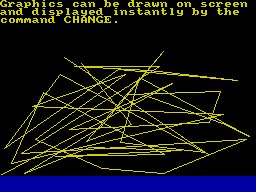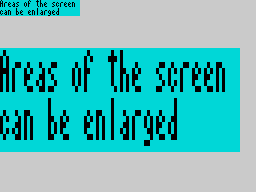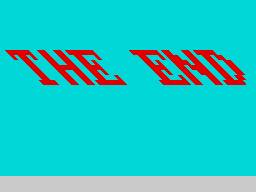| M E G A | |
|---|---|
| D E M O | |
| 1985 is the year of YS MegaBasic! And here for your delectation is a demonstration of its capabilities, courtesy of YS MegaBasic author, Mike Leaman. | |
1075 SREP_1: SOUND_0,0,I,2+2*F,255: SON
1080 VDU_2,13,4
1090 NEXT I
1095 IF (S=6) AND (I=8) AND (F=2) THEN GO TO 1110
1100 CLW_3
1110 NEXT S
1120 NEXT FLines 1020-1120 This loop prints 'YS MEGABASIC DEMO' on-screen in seven different colours, three different fonts and six different stipples. Line 1070 shows how you can print different size characters with the same PRINT statement; character codes 3 and 4 change the size of character output. Line 1080 produces a single-line feed, instead of a double-line feed. Line 1100 homes the cursor, but does not clear the window. Line 1075 produces a continuous sound effect.
1130 PRINT AT 21,0;CHR$ 3;" by Mike Leaman 1985";Line 1130 Prints a message at the bottom of the screen in double-height characters, using control codes in the PRINT statement.
1140 PAUSE 100: SOFF: PLAY_0,5,0,30,5Line 1140 Switches off the Interrupt Sound Generator (ISG) and produces another kind of sound effect using the 'PLAY' command.
1145 PRINT AT 21,0; PAPER 1; OVER 1;" ";Line 1145 Colours the bottom two lines of the display to blue.
1150 CURRENT_4: WINDOW_21,0,2,28
1160 CURRENT_5: WINDOW_21,28,2,36Lines 1150-1160 Set up two windows over the blue strip at the bottom of the screen.
1170 FOR A=1 TO 80
1180 CURRENT_4: PAN_0,-2
1190 CURRENT_5: PAN_0,2
1200 NEXT ALines 1170-1200 Split the blue strip in half by PANning in two different directions.
1204 INPUT ;Line 1204 Sets the colour of the two input lines at the bottom of the screen.
1205 FOR A=1 TO 5
1210 FOR P=1 TO 7
1220 CHANGE_56,8*P
1230 PLAY_1,20,0,20,5*P
1240 NEXT P
1250 NEXT ALines 1205-1250 This routine makes the display flash in eight different colours, by switching the paper colour.
If you check out the screen shots given and read through the listing, you'll see that short though this program is, it'll provide you with first-hand experience of the various character fonts, sizes and stippled characters available, QL-style windows, named procedures, sound effects and a whole lot more! Of course, when you type it in you'll be able to sort out how the MegaSpectrum keyboard operates as well!
If you haven't yet succumbed to the lure of YS MegaBasic, then this program isn't going to put you off! Try writing the same program in ZX Basic and see how many lines of program you'll need ...
Over the next few months, we'll be providing the odd demonstration listing for you to ogle over. Next month, for instance, we'll be showing you how you can create 3D graphics á la Knight Lore in just a few simple lines of YS MegaBasic!
But that doesn't mean we don't want to see your own programs. Send your listings to the YS Towerblock and we'll get Mike Leaman to have a look at them (And we'll be publishing the best of 'em! Ed.). Also, if you're having any problems, write to Mike and he'll try and reply to most of them within the pages of Your Spectrum. Of course, if you've got a major disaster on your hands and you want help instantly, try phoning Troubleshootin' Pete on nn-nnn nnnn - he's only had his copy for a few weeks but he'll try and help you!
Anyway, back to you! Until YS MegaBasic is the only Basic on the Spectrum, Your Spectrum's going to be one of the only places you can get your programs published and get some help on its mastery. So, keep watching these pages! And if you haven't yet joined the thousands of YS MegaBasic users ... what are you waiting for?
16 PCLEARLine 16 Clears the PROCedure stack. You must do this at the beginning of any program that uses procedures or 'REPEAT-UNTIL' loops.
17 REPEATLine 17 Marks the beginning of the main program loop. (This 'REPEAT-UNTIL' loop makes the demonstration repeat itself.)
20 INTROLine 20 Calls the 'introduction' procedure.
30 WINDOWSLine 30 Calls the 'windows' procedure.
40 GRAPHICSLine 40 Calls the 'graphics' procedure.
50 ENDLine 50 The 'end' procedure. This produces a scrolling 'end' message once the demonstration program's finished.
60 UNTIL_0Line 60 Makes the demonstration repeat forever! This is equivalent to the more common 'REPEAT-UNTIL FALSE' loop you'll find in other Basics.
1000 @INTROLine 1000 Defines the beginning of the 'intro' procedure.
1003 MODE_4: CLS Line 1003 Selects large size characters and clears the screen.
1005 WINDOW_0,0,24,64Line 1005 Defines the current window so that it covers the entire screen.
1010 BRIGHT 0: PAPER 0: MODE_4Line 1010 Sets the start-up colours for the 'intro' procedure.
1020 FOR F=0 TO 2
1025 FONT_F: RESTORE 1999
1030 FOR S=1 TO 6
1040 READ Z: STIPPLE_Z
1050 FOR I=1 TO 7
1060 INK I
1070 PRINT CHR$ 3;" YS MEGABASIC ";CHR$ 4;"DEMO"
It had to happen! Our plans to have YS MegaBasic ready for public consumption by January 1st, 1985, were scotched at every turn. Here at YS, we'd like to apologise to all who received YS MegaBasic a few days late - thanks for having patience with us and we hope you thought the wait worthwhile! Needless to say, all deliveries of YS MegaBasic are now under control. Of course, there won't be this trouble next time ...

Making use of all the available character fonts and stipples, the demo's title screen includes musical accompaniment from YS MegaBasic's 'SOUND' and 'PLAY' commands. This part of the program is displayed in Mode 4, where each character is 16 by 16 pixels; there's also good use of the 'STIPPLE' command.

You can have up to ten windows on- screen at any one time, all of which can be controlled independently through simple YS MegaBasic commands. At this stage of the demo, four windows have been created and YS MegaBasic is scrolling each of them, pixel by pixel, in different directions via the 'PAN' command.


